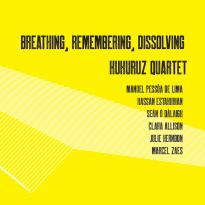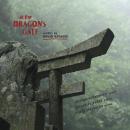Breathing, Remembering, Dissolving
Breathing, Remembering, Dissolving
| Breathing, Remembering, DissolvingiTunes Artist's PageiTunes Album Page | |||
|---|---|---|---|
| Song Title | Time | Price | |
| 1. | In My Body (The Room That Will Outlive Us) | 06:44 | $0.99 |
| 2. | Ruainne III | 10:44 | |
| 3. | When the Machine Rhymes with My Body | 12:23 | |
| 4. | Dissolving Archives I | 16:01 | |
| 5. | Forty Finger Machine | 06:49 | $0.99 |
| 6. | From Memory | 07:38 | $0.99 |
Breathing – Remembering – Dissolving is a collaborative record bringing together a collection of contemporary experimental musical perspectives that all share a common interest: challenging the idea of what the human is in a musical performance. Composers, Clara Allison, Seán Ó Dálaigh, Julie Herndon, Hassan Estakhrian, Manuel Pessôa de Lima, and Marcel Zaes, contribute unique responses to themes we typically associate with being human, the body, and the larger aspects of sociality in/with/around humans.
The project collects six works by composers of various backgrounds, gender and racial identities, and diverse musical styles, coming from the San Francisco Bay Area, United States, Latin America, and Europe. Each original work was created specifically for the Kukuruz Quartet while in residence in the Bay Area.
Based in Switzerland, the Kukuruz Quartet— 4 pianists on 4 pianos — is a close-knit group of divergent artistic personalities, all trained in disparate musical fields: Simone Keller is a versatile pianist in contemporary and classical music, Philip Bartels is an experimental theater stage director, Duri Collenberg studied composition in Amsterdam, and Lukas Rickli has broad experience in improvisation. They are equally at home on theater stages, concert halls, clubs, bars, office buildings, and studios.
The ensemble was founded in 2014 in a corn field — Kukuruz means "corn" in several languages. These four pianists were first seen and heard making their contribution to a production by musician and theater director Ruedi Häusermann at the Zurich Schauspielhaus. From the outset, the group has been engaged with classical music, jazz, and improvisation.
This album is sponsored by Innova Recordings and American Composers Forum’s Bay Area Pilot program with support from Pro Helvetica and the Stanford Department of Music.
LINER NOTES
in my body (the room that will outlive us)
clara allison
‘we were in our own bodies
(that room that will bury us)
and you were in my body
(that room that will outlive us)’
-Anne Sexton, ‘Us’
This sonic space is interested in ‘within’. Enclosed together– positioned between pianos – players stretch from the keyboards’ edges to their centers – from separation to entanglement.
if my heart had rooms like a whales’—
and you wanted to find a space in them —
Ruainne III
Seán Ó Dálaigh
for piano quartet and fixed media
The Irish word ruainne translates as ‘fragments’ or ‘threads’. This work is part of a series.
Each one is a transcription of the same piano recording which has been living on my hard drive for 5 years as drone.wav.
It is a recording of an improvisation on a piano using a cello bow. The bow is wrapped around the lowest A and C strings and the sostenuto pedal is kept pressed down always. The improvisation varied bow pressure and speed with lots of space to listen to the shimmering and visceral resonance of the metallic strings.
The electronic transcription process fragments this recording. It is an attempted representation of the very complex sonic texture. You are left with tens of thousands of transcribed notes as MIDI data. The act of re-composing this transcription into something legible for a new context (4 pianos and tape for example) is, on the surface, an attempt to deal with the 1000’s of possibilities the material presents. But it is also to deal with the issue of fragmentation in general, foregrounding the issue of choice in the face of the fragmented realities we are living in.
This idea was informed by a close friend, a writer and composer, Emile Frankel. In his book Hearing the Cloud Frankel argues for responsible choice as radical resistance to the potential for apathy in fragmented dystopian aesthetics.
The piece is dedicated to Sophie Fetokaki for showing me how to take instruments apart with care.
When the Machine Rhymes with my Body
Julie Herndon
A body synchronizes different senses of time. Fleeting biorhythms of breath and pulse combine to create long-form tempos of hours and weeks. An instrument also embodies time in the vibrations of a string journeying to decay from the force that excites—combining to create melody and form.
In this piece, each players first attune to the tempo of their heartbeat. Each pulse played on the keys incites the hammers like mechanical fingers. The players then join a canon based on the tempo of their breath. The piece continues to move through these internal and collective senses of time, connecting the machine of the piano to the body that plays it.
Dissolving Archives I
Marcel Zaes
for piano quartet using smartphones, reenacting their personal sonic diary
“Dissolving Archives I” is a piece about the human capacity of remembering; a capacity that is increasingly assisted, and extended by, ubiquitous everyday technology. Long before the performance, the players are each asked to record a “sonic diary” by way of attempting to remember things on their minds that are about to slip and escape from their memory; they are prompted to do so by reproducing faint and blurred recollections on a piano instrument – an arguably insufficient tool to precisely capture and archive the (sonic) past. The performers thus create diary entries on piano, recorded on their personal phones, which are written and stored on a shared web server. From there, the collected archive – a technologically perfect memory of what is an imperfect piano-recreation of the pianists’ recollections – is made available to the pianists again. In the moment of performance, they re-activate the constructed archive via their phones, as they are now tasked to repeat on the piano what they hear their phones playing from the archive. Yet given the overwhelming nature of the task – repeating an innumerable amount of diary entries at once – they necessarily fall back upon the qualities of human remembering. “Dissolving Archives I” is thus marked by artifacts of omitting, of sole adequacy instead of mastery, of failure and forgetting. What remains is a soft and porous sonic world crafted by the performers and the repeated processes of (re)mediation; a sonic world that becomes gradually denser and yet dissolves.
Forty Finger Machine
Hassan Estakhrian
Forty Finger Machine is the result of a musical game played by Kukuruz. The game is called Machine, where each musician plays different roles over the course of the piece's duration. There are five possible roles— a sustainer, a pulser, an interjector, a complementor, and a listener. Each role acts as a single entity within the overall sonic machine. Players draw a predetermined number of role cards. Each player then flips over one card at a time and takes on that role.
From Memory
Manuel Pessoa de Lima
sound collage
I wrote each pianist a letter to be opened and read during the recording session. In the letter, I ask them to play or even practice some excerpts of pieces that were somehow emblematic of their formative years with the piano. This becomes the source material for a collage piece, where I process these fragments, creating multiple sonic layers of this collection of memories, intertwining the processed sounds with the unaltered recordings. Among improvised material, snippets of the following pieces appear: Study for Mixed Accents (Ruth Crawford), Prelude (Julia Perry), Sonata KV540 (Mozart), Guernica (Paul Dessau), Visions Fugitives (Prokofief), Chanson Pour L' auvegnat (Georges Brassens) and Pour Le Piano (Debussy). The collage wanders through hesitating gestures, in the pianist's attempt to recall the muscle memory of pieces they once learned. In this sense, the poetics of memory appears as what it forgets, and in its directionlessness, inaugurates another, actualized, memory.



